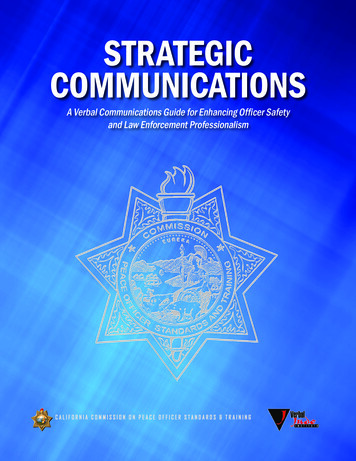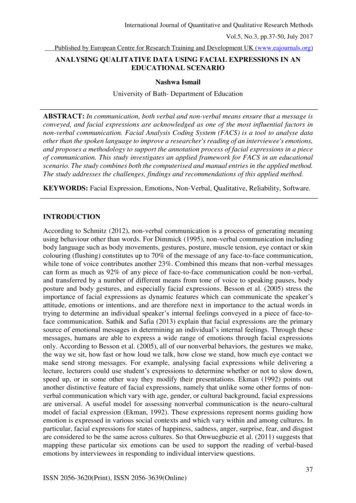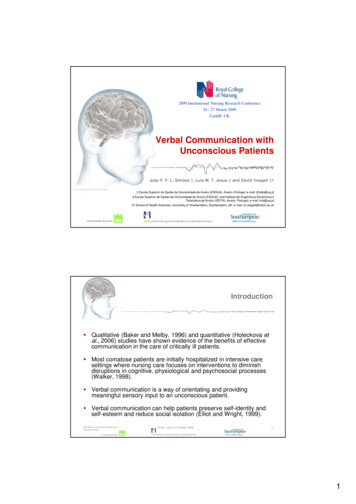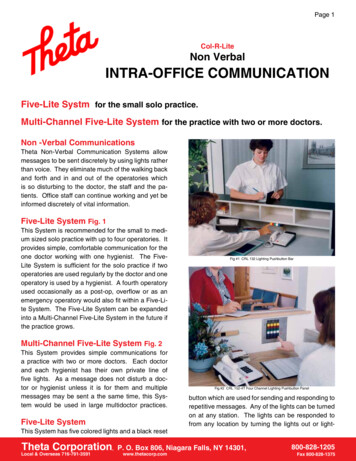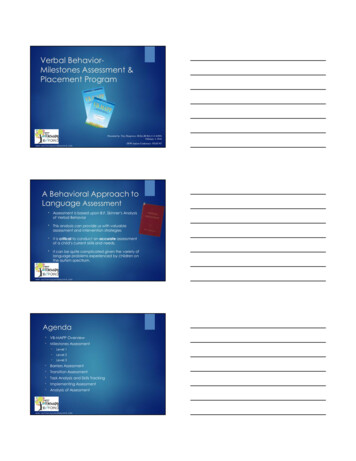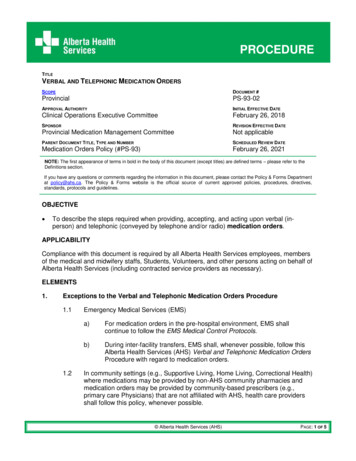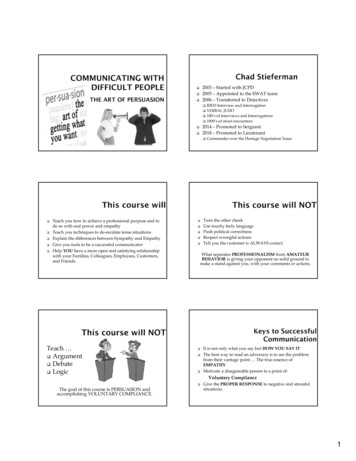
Transcription
2003 – Started with JCPD2005 – Appointed to the SWAT team2006 – Transferred to Detectives 2014 – Promoted to Sergeant2018 – Promoted to Lieutenant Teach you how to achieve a professional purpose and todo so with real power and empathyTeach you techniques to de-escalate tense situationsExplain the differences between Sympathy and EmpathyGive you tools to be a successful communicatorHelp YOU have a more open and satisfying relationshipwith your Families, Colleagues, Employees, Customers,and Friends.Teach Argument Debate Logic Commander over the Hostage Negotiation TeamTurn the other cheekUse touchy feely languagePush political correctnessRespect wrongful actionsTell you the customer is ALWAYS correctWhat separates PROFESSIONALISM from AMATEURBEHAVIOR is giving your opponent no solid ground tomake a stand against you, with your comments or actions. It is not only what you say but HOW YOU SAY ITThe best way to read an adversary is to see the problemfrom their vantage point The true essence ofEMPATHYMotivate a disagreeable person to a point of:Voluntary Compliance The goal of this course is PERSUASION andaccomplishing VOLUNTARY COMPLIANCE.RIED Interview and InterrogationVERBAL JUDO100’s of Interviews and Interrogations1000’s of street encountersGive the PROPER RESPONSE to negative and stressfulsituations.1
The NiceThe DifficultThe Wimp Will NOT do what you tell them the FIRST time nomatter how diplomatic you areIt’s not in their nature to say “Oh Yes”They want the “WHY” and “WHAT FOR” “WHY” can be one of the most powerfully destructive orconstructive words in any languageDo Not resist your opponent or shut out pesky questions.You MUST answer and not dismiss the question!!Difficult people are as eager to argue apoint as Nice People are to simply cooperate Nice Nice people won’t be a problem for you but if youdon’t treat them right over time you will losecredibility and they will stop supporting you Treat FAIR and with RESPECTProvide them with the facts; “Why” and “What For” along withEXPLANATIONS. Be able to defend your positions or decision. Strip them of their camouflageCONFRONT them HONESTLY but DON’T EMBARRASS them,let them embarrass themselves.Learning to identify and distinguish the Nice,Difficult, and Wimp is the first step in masteringCommunicationCome Here Interpreted as “Go Away”Instead say “Can we talk”You Wouldn’t Understand Wimp Look and sound like Nice People but are closer toDifficult PeopleThey will agree and say, “Oh Yes”, “You Are Right” butlater Stab You In the BackThey talk behind your back to your coworkers, bosses,friends, or anyone that will listenThey file lawsuitsWimps don’t like authority and hate beingtold what to do but don’t have the guts tochallenge the authorityDifficult Will do what you ask them to do the first time you askThey like to cooperateWill do what they are toldHave a hard time saying NOHave a hard time sticking up for themselvesInterpreted as “Stupid”Instead say “Let me try and explain”Because Those Are the Rules Interpreted as Insensitive, Uncaring, or only being concerned withyour authorityInstead place the rule and policies in a context that will explainhow they contribute to everyone’s wellbeing.2
It’s None of Your Business What Do You Want Me To Do About It What’s Your Problem Interpreted as a sarcastic comebackInstead give concrete examples of how things will improvebecause of this actionInterpreted as you don’t respect their positionInstead paraphrase their own words by saying “Let me see if Iunderstand your position” and then give their position in yourown words.This is almost always a lieInstead emphasize the seriousness; “It’s important that youunderstand this, so let me say it again and please listen carefully”Do you remember EVERY spanking you received as a child?Now how about a SPECIFIC, personal slam from someone youcared about?So, is the phrase “Sticks and Stones may break my bones, butwords will never hurt me” really accurate?A wound inflicted by hand or even a weaponwill heal and fade from memory over time,but verbal wounds never fully heal. EMPATHYInterpreted as a generalization and is rarely trueInstead state the issue and explain how it makes you feelI’m Not Going to Say This Again Are you looking for an instant TENSIONbuster?Interpreted as YOU vs MEInstead say “What’s the problem and how can I help”“You Never” or “You Always” Why Don’t You Be Reasonable This command almost always makes people more upsetInstead look them in the eyes, touch them gently (If Appropriate)and tell them “It’s all going to be all right”I’m Doing This For Your Own Good Interpreted as sarcasmInstead offer support and help sort out the problem or point themto the right person to helpCalm Down Interpreted as you don’t have a good reason for answering thequestionInstead explain why the information can’t be revealed. DOES NOT mean SympathyYou don’t have to approveYou don’t have to agreeAbsorbs tensionYou are seeing the problem through the EYES OF THE OTHEREmpathy is the quality of standing in another’sshoes and understanding where they are comingfrom.3
When we employ the words that most naturallycome to our lips, we run the risk of giving thegreatest speech we’ll ever live to regret. We windup saying things we can never take back. Thishappens most often when we allow others to set thetone in confrontations. Our words should be KIND, ENCOURAGING, &HELPFUL A good man brings good things out of the good stored up in hisheart, and an evil man brings evil things out of the evil storedup in his heart. For the mouth speaks what the heart is full of.Luke 6:45 A gentle answer turns away wrath, but a harsh word stirs upanger. Proverbs 15:1 Likewise, the tongue is a small part of the body, but it makesgreat boasts. Consider what a great forest is set on fire by asmall spark. James 3:5Alcohol / DrugsImpatienceFrustrationLack of Self-WorthFearDefensivenessThis could be a criminal, customer, spouse, kids, co-worker,salesperson, customer service rep, etc.Do not let any unwholesome talk come out ofyour mouths, but only what is HELPFUL forbuilding others up according to THEIR NEEDS,that it may benefit THOSE who listen.Ephesians 4:29 Girl breaks up with Father's Teenage SonSon wants to post damaging things about the female onsocial mediaFather convinces son to wait 24 hours and then reevaluate.Speaking out of anger will always lead to regret.Giving yourself time of cool reflection will almostalways change your response.When you . REACT, you’re being controlled by the situation RESPOND, you’re dealing with the situationYou will need to STAY CALM, read your opponent andattempt to redirect their aggression in a more positive way4
Abbreviated versions of wordsDeflectionSpring you over the insultsDisempower the other person ‘preciate – Appreciate Understan’ – Understand T’at – That B’lieve – Believe Don’t use strip phrases when the person is agitatedthat you’re clearly deflecting and not dealing with theconflict at hand. Skip the strip phrase and deal withissues immediately. Let the person say what they want as long as theydo what you say People yelling insults don’t mean what they say They are onlyupsetFocus on their behavior not their attitudeAlways go for the WIN / WIN solution Let them get their emotions out if they are doing what you want themto doLet them have the last word to save face in front of friends and familyIf you take away people’s LAST WORD and have the LAST ACT,you could create a violent scenario and make enemies.Let them spout off They WIN and you WIN I got t’ah ma’am but .I b’lieve that sir but . REspect is what you have to show all people at all respect is how you FEEL towards someone basedtimeson the person or their behavior or actionsYou may not respect law breakers, disgruntledcustomers, or rude people, but as a professional youmust show them REspect while dealing with them.The GOLDEN RULE!!Start with the SWORD OF INSERTION Cut into their tirade and take Control “Whoa”, “Listen”, or “Wait a second” NOT – “Get to the point!”Follow up with the ULTIMATE EMPATHETICsentence! Paraphrasing: Putting another personsmeaning in your own words and deliver itback to them to ensure understanding.I understand’ that sir but .Everything after the BUT is designed to get the job done andwhere you place your desired outcome. The only way to INTERRUPT people andSTILL have them LOVE and RESPECT you.I ‘preciate that but .“Let me be sure I heard what you just said”Now paraphrase their meaning back to them Okay, you are feeling X because of Y, right? The X anemotion (anger, frustration, etc.) and the Y thesituation/problem.You don’t have to be right. You’re just guessing at thispoint.5
It’s unprofessional because you are using words toexpress YOUR personal feelingsBurns bridgesAlienates peopleCreates lost opportunitiesMakes you feel good about yourself TEMPORARILY I told him!He had it coming!A few hours later Regret I should have said something else!Why did I say that?Why did I have to shoot off my big mouth?You CAN’T take back harmful words.People don’t forget verbal abuse!!More complaints come from what yousaid to someone then what you did tothem!!Use your words to achieve anobjective of your choice.The goal of PERSUASION is to gainVOLUNTARY COMPLIANCE.RepresentationTranslationMediationBUT .It is important that you know what your FOLLOWUP OPTIONS are if WORDS FAIL. We all have BUTTONS and TRIGGERS!!If you’re going to work for others andrepresent them, you must not allow peopleto push your button and pull your trigger.How do you build a - TRIGGER GUARD? Know yourself and what your triggers are. Ifyou don’t know yourself, you lose 100% of thetime.When you speak, you’re a mouthpiece and arepresentative. You do not represent your own ego.Remember, the more ego you show, the less poweryou have over people.LawsCompanyPolicy &ProceduresEGOYouAnger FearCustomerDrugs Anxiety6
Remember if you don’t know yourself, you will lose100% of the time.The ability to put what you say in the mostproper, fitting, assertive, and powerfulwords possible.If you know yourself but you don’t know youropponent you will be lucky to win 50% of the time.If you know yourself and you know your opponentyou can win 100% of the time.How do you put your precise meaning intothe mind of your listener?One of the greatest communication skills is LISTENING,really listening to people; Not only what they say but howthey say it.CodingContent You have to know: EXACTLY what you're TALKING ABOUTBe KNOWLEDGEABLE in the content Know your products, policies & procedures,and the law. Sending Once you know what you're going to sayand how you're going to say it you have totransmit it Your voice: Tone & PitchYour nonverbals: Facial Expressions, BodyLanguage, Posture, Eye Contact, etc.They all have to support the sincerity ofyour messageYou have to put your message into words thatreflect your meaningThe words you choose must be ones that will beunderstood by the person you're delivering themtoDon’t talk above or below your recipientIf you find yourself having trouble communicatingwith people of different walks of life, it may bebecause you’re thinking of yourself instead of themIf you allow your ego to get in the way you willcommunicate in your own language not thelanguage of the other personDecoding This is the responsibility of the recipient,but it is in direct proportion to howeffective your content, coding, and sendingwere accomplishedThis could also be affected by externaldistractions and the recipients owninternal mental noise or influences7
ListeningThe art of listening is:Listening NOT A NATURAL ACT To become an ACTIVE listener you must do 4things: Be OPEN and UNBIASED HEAR the literal words spoken INTERPRET the data INTERPRET the acting NEVER react to what people SAYReact to what they MEAN“Whoa”, “Listen”, “Wait a second”Then agree with them, tell them they are rightabout whatever they think their issue is andyou want to help them resolve itThis doesn’t mean they are right it just meansyour agreeing, THEY think there is a problem Now that we have taken control of theconversation we are going to try and getthem to see something newBased on what the complaint is we can usemany different baits to appeal to them People under the influence of liquor, drugs,rage, fear, anxiety, ignorance, stupidity, or biasdon’t mean what they sayIf you respond in the same demeanor youwill lose 100% of the timeListeningYou have to take control of theCONVERSATION.Use a Sword of Insertion People Hardly Ever Say What They MeanWhen They Are AggravatedThe value of time, money, job, family,craftsmanship, reputation, relationships, etc.Just remember:People hardly ever say what they mean If your opponent or customer hassomething to GAIN or LOSE, you havesomething you can useSimply put you’re going to skillfullypresent options8
Content carries a weight of: 7 – 10%Voice carries a weight of: 33 -40%Nonverbal carries a weight of: 50 – 60%There are four elements to the voice:Tone (Most Powerful of the 4) If your on the phoneContent carries a weight of: 7 – 10%Voice carries a weight of: 73 – 90% PaceYour Speed, How fast you talk Nonverbal Communication PitchHow high or low and how loud or soft youspeak ModulationIt’s your rhythm and inflectionConveys your TRUE ATTITUDE toward the personThere are many times when your voice must lie andyou will have to camouflage your tone but you haveto be convincing or you will make it worseTone has caused more complaints, violence,divorce, loss of business, and hatred then anythingelse Facial expressionsMicro expressionsUse of HandsPosture (Closed or Open)Eye ContactClothingGroomingSweatingToe/Pencil tappingProximity9
Remember, up to 93% of your SUCCESSwith people has to do with YOURDELIVERY and only the slightest percenthas to do with what you actually sayA mediocre idea brilliantly presented oftengains acceptance, whereas a brilliant ideabadly presented often dies in birthPACE ProblemThere are always 2 kinds of problems Your Problem: The way you see it as a professionalTheir Problem: The way they see it as a customerThe two of you will probably never see the problemthe same way. The only way to succeed in thesesituations is to define the problem from the customerspoint of view first.Audience Just about anything can be a constraint Rage, mental illness, belief system, life influences,uprising, values, ethics, etc.There are only three things you can do with aconstraint:Step around it Ignore it Use it How does your customer differ from you?How does your customer see the problemdifferent then you?What are your customers values and beliefs?Ethical PresenceConstraints Problem (Situation you are in)Audience (To whom are you speaking)Constraints (Obstacles to effectivecommunication)Ethical Presence (Your professional face) If you can’t convince the customer that you aretrying to work with them your going to failYou must put on your professional face and showconcern at all times even if your bluffingThis is not about conning someone into unrealisticexpectations. It is addressing their problem from alanguage they understand to find an outcome thatbenefits them and the company10
Define the Problem!Determine how your Audience sees theproblem and how they differ from you?All people want to be . What are the Constraints that are making theinteraction difficult? Treated with DIGNITY and RESPECTASKED rather then TOLD to do somethingINFORMED as to why they are being ASKED orORDERED to do somethingGiven OPTIONS rather then THREATSGiven a SECOND CHANCE when they make a mistakeKeep a concerned and caring face!1. All cultures want to be respected and treatedwith dignity regardless of the situation When treated with disrespect - all people want tofight and get revenge2. All people would rather be asked then toldwhat to do To ask is a sign of respectTo tell is often a sign of disrespect5. Finally, all people want a second chance tomake matters right People are human and we err and act in wayswe wish we had notWhenever appropriate, people value beinggiven a second chance to get it right3. All people want to know why they are being askedor told to do something Telling people the why is another sign of respectNot telling people why is a sign of disrespect andlowers morale4. All people would rather have options than threats Providing a choice shows respect and allowspeople to save face Threats are disrespectful and forces people thathave a backbone to resist and fight backThe first truth “Treat everyone with dignityand respect”MUST BE FOLLOWED AT ALL TIMES NOEXCEPTIONSThe other 4 are subject to the SAFERconcerns.11
Security of people or property under AttackUnlawful Flight from ones lawful presenceExcessive repetitions: we have covered all ourverbal bases and have no complianceRevised priorities:Something unexpected happens that is of greaterconcern or severity and must be handledimmediately with no time for talking Words may become secondary, actions primary If you learn the underlying principals, you don’t need toremember every detail of the training or every step ofeach process.Give people Reassurance and strive to calm them downand reduce the tension.Use Empathy: Empathy Absorbs TensionA surefire way to increase tension is to allowyour ego to guide the conversation or bytelling someone to calm down. Chabris, C. F., & Simons, D. J. (2010). The invisible gorilla: And other ways ourintuitions deceive us. New York: Crown. Simons, D. (2010, March 10). Selective Attention Test. Retrieved from YouTube:https://www.youtube.com/watch?v vJG698U2Mvo Simons, D. (2010, April 28). The Monkey Business Illusion. Retrieved fromYouTube: https://www.youtube.com/watch?v IGQmdoK ZfY The Holy Bible. (1984). New International Version. Grand Rapids: ZondervanHouse. Thompson, G. J., & Jenkins, J. B. (1993). Verbal Judo: The Gentle Art ofPersuasion. New York: Morrow.12
1 2003 – Started with JCPD 2005 – Appointed to the SWAT team 2006 – Transferred to Detectives RIED Interview and Interrogation VERBAL JUDO 100’s of Interviews and Interrogations 1000’s of street encounters 2014 – Promoted to Sergeant 2018 – Promoted to Lieutenant Commander over

